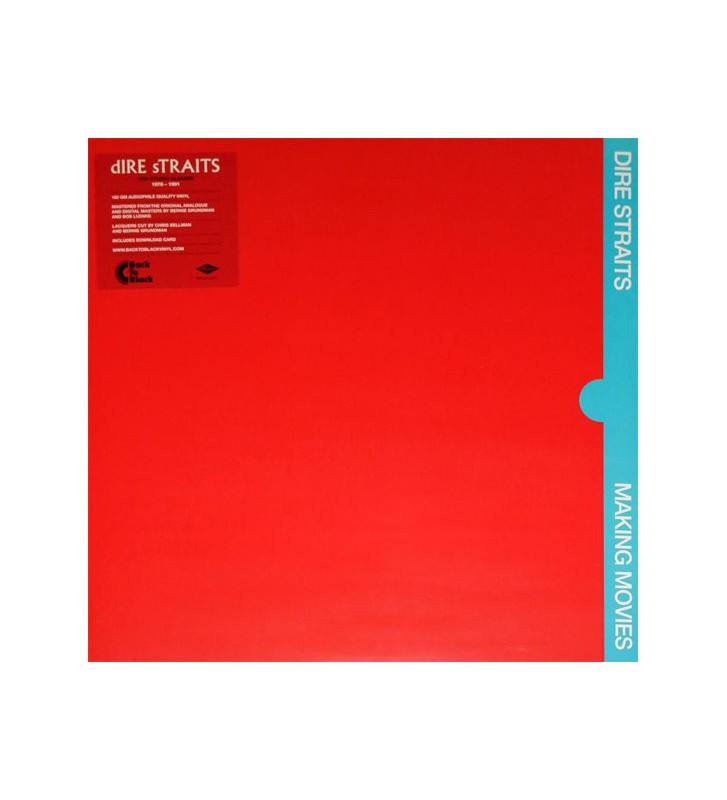
It opens with an odd little organ and piano interlude that seems like it belongs on a vaudeville stage more than a rock album, which makes sense since it is actually “The Carousel Waltz” by Rogers and Hammerstein. The needle drops onto the spinning black surface, hitting a band that takes up over a third of the space, and you are met with the opening notes of “Tunnel of Love.” Clocking in at over eight minutes, the song signals that this is not going to be a pop rock fest based on four-minute singles, but instead a conceptual album meant to be listened to from first note to last. On the front side are pictures of the three band members, starting with a dreamy-looking Knopfler (his brother, David, having left the band in the middle of recording over creative differences, was replaced by session guitarist Sid McGinnis, and both went uncredited). The inner liner is almost as barren, the same blue with lyrics running in tiny print (and all in lower case) along the edge on either side. A semicircular notch is cut out in the center of this line, making the whole thing resemble an oddly colored floppy disk in its sleeve (remember when floppy disks were actually floppy… for that matter, remember floppy disks at all?).


The cover of the album is very plain, solid red front and back with just a small blue line running along the edge that announces the band name and album title in white, capital, sans serif letters. It even features keyboards from the E Street Band’s own Roy Bittan, who plays to great effect on almost every song. It was the debut of their more complex sound, the first to include long-form tracks (they eventually topped out at over fourteen minutes with Love Over Gold’s “Telegraph Road,” which would make any progressive rock band proud), and includes some of Mark Knopfler’s best compositions, both musically and lyrically. Few people remember it today, but it was a powerhouse through and through. Without a doubt, Dire Straits’ masterpiece is their third album, 1980’s Making Movies. In fact, every LP that preceded it was nearly as good, if not better. For that matter, Brothers in Arms, as good as it is, is not their best album. It’s decent enough if you can get over the cliché that it quickly became, but it’s not in their top ten, maybe even twenty. The other problem is that “Money For Nothing” was not the band’s best song. Given all of that, the fact that the band is reduced in the modern consciousness to just one (maybe three) songs is an absolute lowdown shame. They were the alternative before people knew an alternative was needed. was the grandfather of alternative rock, but that’s bunk. At the same time, they were pushing the envelope musically, their early roots-based rock standing in stark contrast to the predominance of punk and their later, more complex recordings finding a happy medium between progressive rock and regular good ol’ rock n’ roll. “Bothers in Arms” was the first CD single ever and the album was the first to include CD-only extras like extended song versions not available on the LP… it can be fairly said that Brothers in Arms made the CD popular. Ok, CDs are an abomination, but they were the new thing back then, and a major technological leap. The group also pushed the envelope on digital recording and the CD format. Guys like Clapton and Hendrix get all the glory-and rightly so considering their innovation-but Knopfler had a way of transferring emotion from head to fingers to strings to sound unmatched in the history of rock n’ roll. In fact, he may be one of the most underrated guitarists in history.

Frontman Mark Knopfler was (and is) a master lyricist, not to mention a pretty damn fine guitar player. With influences ranging from rock to jazz to blues to folk to beatnik poetry, they had a sound that was absolutely unique. The album featured no dobros they just thought it looked cool.įirst off, Dire Straits was one of the most creative bands that ever existed (not to mention the biggest band in the world after the release of Brothers in Arms… at one point, 1/10th of all households in Britain owned the album, including the Queen’s). Quite possibly the most famous resonating guitar in history, from the cover of Brothers in Arms.


 0 kommentar(er)
0 kommentar(er)
